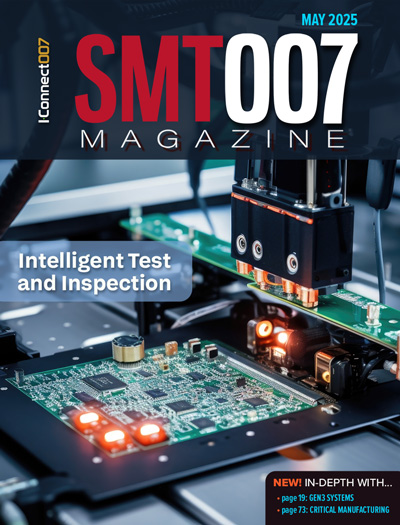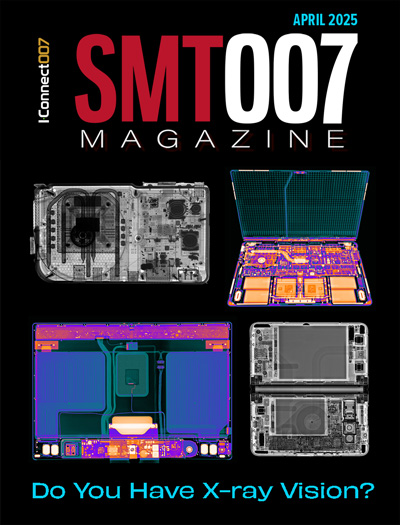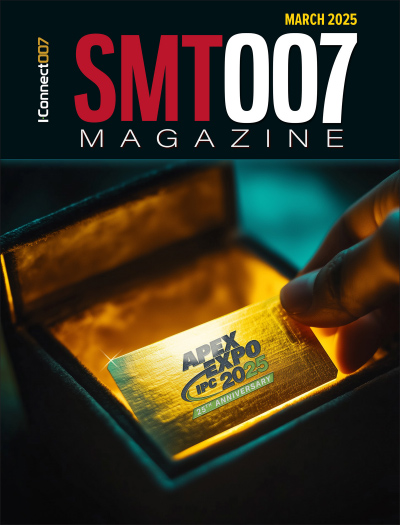-

- News
- Books
Featured Books
- smt007 Magazine
Latest Issues
Current Issue
Intelligent Test and Inspection
Are you ready to explore the cutting-edge advancements shaping the electronics manufacturing industry? The May 2025 issue of SMT007 Magazine is packed with insights, innovations, and expert perspectives that you won’t want to miss.

Do You Have X-ray Vision?
Has X-ray’s time finally come in electronics manufacturing? Join us in this issue of SMT007 Magazine, where we answer this question and others to bring more efficiency to your bottom line.

IPC APEX EXPO 2025: A Preview
It’s that time again. If you’re going to Anaheim for IPC APEX EXPO 2025, we’ll see you there. In the meantime, consider this issue of SMT007 Magazine to be your golden ticket to planning the show.
- Articles
- Columns
Search Console
- Links
- Media kit
||| MENU - smt007 Magazine
ELCOSINT - The Future of High Temperature Interconnect
September 22, 2015 | Pete Starkey, I-Connect007Estimated reading time: 4 minutes
The increasing need for electronic assemblies to endure high-temperature operating conditions in aerospace, automotive, oil and gas drilling, power management and renewable energy applications, whether those conditions involve high ambient temperatures, high cycle temperatures or high junction temperatures, is driving the development of high temperature interconnection technologies. And the anticipated expiration of RoHS exemptions on the use of lead-based high melting point solder alloys justifies the exploration of alternative routes to achieving reliable interconnection whilst not departing fundamentally from established assembly process flow or processing temperatures.
The Electronic Component Sintered Interconnections (ELCOSINT) collaborative R&D project, supported by Innovate UK, set out three years ago to develop novel polymeric, sintered interconnection materials to replace high-lead-content materials and further increase the operating temperature capability of electronic assemblies to 225°C and beyond. As the project approaches its conclusion, the project partners Microsemi Semiconductor, Gwent Electronic Materials and National Physical Laboratory have presented their findings to date in a webinar moderated by Bob Willis. Microsemi Semiconductor specialises in electronics packaging and system integration for high value high reliability applications, Gwent Electronic Materials is a specialist developer of novel inks and materials for the electronics and medical diagnostic industries, and National Physical Laboratory is the UK’s national measurement institute.
Trace Wotherspoon, Senior Electronic Design Engineer at Microsemi, gave a general introduction and reviewed the project objectives: to develop a printable “solder paste like” material capable of operation at temperatures above 225°C, but processable at low temperature, and lead-free. Besides providing electrical interconnection between substrate and components, the material required adequate bond strength to support the joint at high operating temperatures throughout the life of the assembly. From a processing point of view it needed to be usable in a standard SMT assembly flow, with good shelf life and pot life. Finally, it needed to be financially competitive with established materials.
Laura Statton, Development Chemist at Gwent described the preparation of a range of conductive adhesives based on silicone resins capable of sustained high temperature operation, compounded with nano and macro silver powders and flakes, metallo-organics and solvents to produce printable pastes capable of being sintered at low temperatures. The materials had been further developed to increase screen life and stand-off height and three formulations had been supplied to Microsemi for evaluation in the building of demonstrators.
Fiona Lambert, Senior Process Engineer at Microsemi reviewed basic processing requirements: paste rheology and particle size compatible with fine-pitch stencil printing, and sufficient tackiness at room temperature to hold components in position during placement. Evaluation of initial formulations revealed issues with smearing and drying on the stencil, together with streaks and peaks on the deposit. In cooperation with Gwent, a series of systematic DOE cause-and-effect exercises with materials, solvents and print parameters resulted in improved print performance, particularly on small pad sizes. A tendency to voiding on curing was eliminated by further experimentation with printing and curing parameters. This also led to improved control of stand-off height, which had been observed to have a significant effect on joint strength. Once optimum process parameters had been established, sample assemblies passed a series of qualification tests to IPC-A-610, J-STD-020 and MIL-STD-883 for moisture sensitivity, thermal and mechanical stress. A high temperature automotive amplifier, normally assembled with high-lead solder, was built as a demonstrator product for Elcosint material.
Martin Wickham, Senior Research Scientist with the Electronic Interconnections Group at the National Physical Laboratory, discussed in detail the results of fitness-for-purpose testing. The test vehicles chosen were high-temperature resistor structures on polyimide-glass or PTFE-ceramic PCBs with ENEPIG finish, or ceramic substrates with thick-film gold finish. The component termination finish was platinum-silver. Elcosint pastes were printed using a laser-cut 75 micron stainless steel stencil with apertures of 100% or 50% of pad area and the components were auto-placed. The only departure from standard SMT practice was a batch-oven cure at 250°C for 35 minutes instead of conveyorised reflow. The assembled test vehicles were subjected to extended ageing with electrical and shear force measurements, using samples assembled with high-melting-point solder as a reference. Results were shown for ageing conditions of 7,000 hours at 85°C/85%RH, 6500 hours at temperatures of 250°C and 300°C, and 500 hours at 250°C followed by 2750 thermal cycles of -55°C to +125°C. In every case, the Elcosint materials out-performed best-in-class high-melting-point solder, maintaining a combination of low-resistance electrical continuity and good bond strength. Fourier-Transform infra-red spectroscopy offered a means of monitoring long-term resin degradation effects.
In certain of the high-melting-point soldered assemblies, some failures of copper tracks were observed, and it was believed that a contributing factor was the high peak reflow temperature - approximately 325°C - causing degradation of the structure of the printed circuit. A great benefit of the Elcosint technology was that the highest temperature seen during assembly was the 250°C cure cycle, so that the substrate and components were exposed to significantly less thermal stress. Soldering showed one physical advantage in the assembly process through its ability to self-align components by surface tension during melting and wetting. For this reason, accurate pick-and-place positioning was critical when Elcosint materials were used.
The outcome of the Elcosint project has been to produce a range of new high-temperature interconnect materials that offer a technically and commercially viable alternative to solder. The collaborative partners continue to work together in a new project named Tamessa which aims to develop an integrated system to eliminate the need to use expensive and heavy ceramic technologies in applications up to 225°C and allow the integration of bespoke through hole components
Suggested Items
Indium’s Karthik Vijay to Present on Dual Alloy Solder Paste Systems at SMTA’s Electronics in Harsh Environments Conference
05/06/2025 | Indium CorporationIndium Corporation Technical Manager, Europe, Africa, and the Middle East Karthik Vijay will deliver a technical presentation on dual alloy solder paste systems at SMTA’s Electronics in Harsh Environments Conference, May 20-22 in Amsterdam, Netherlands.
SolderKing Achieves the Prestigious King’s Award for Enterprise in International Trade
05/06/2025 | SolderKingSolderKing Assembly Materials Ltd, a leading British manufacturer of high-performance soldering materials and consumables, has been honoured with a King’s Award for Enterprise, one of the UK’s most respected business honours.
Knocking Down the Bone Pile: Gold Mitigation for Class 2 Electronics
05/07/2025 | Nash Bell -- Column: Knocking Down the Bone PileIn electronic assemblies, the integrity of connections between components is paramount for ensuring reliability and performance. Gold embrittlement and dissolution are two critical phenomena that can compromise this integrity. Gold embrittlement occurs when gold diffuses into solder joints or alloys, resulting in mechanical brittleness and an increased susceptibility to cracking. Conversely, gold dissolution involves the melting away of gold into solder or metal matrices, potentially altering the electrical and mechanical properties of the joint.
'Chill Out' with TopLine’s President Martin Hart to Discuss Cold Electronics at SPWG 2025
05/02/2025 | TopLineBraided Solder Columns can withstand the rigors of deep space cold and cryogenic environments, and represent a robust new solution to challenges facing next generation large packages in electronics assembly.
BEST Inc. Reports Record Demand for EZReball BGA Reballing Process
05/01/2025 | BEST Inc.BEST Inc., a leader in electronic component services, is pleased to announce they are experiencing record demand for their EZReball™ BGA reballing process which greatly simplifies the reballing of ball grid array (BGA) and chip scale package (CSP) devices.


